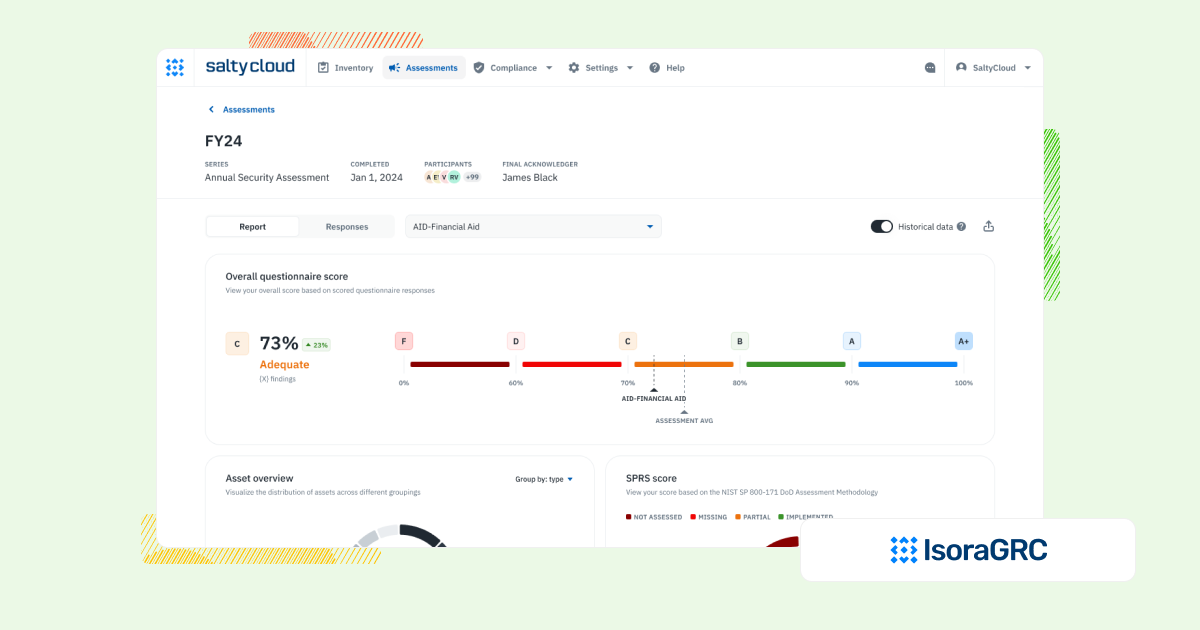
Every security team needs a lasting, scalable way to manage IT risk—not just speed through audits.
Platforms like Hyperproof and Drata specialize in compliance automation, making it easier to prepare for certifications like SOC 2 and ISO 27001.
These tools automate audit prep, but don’t support the deeper workflows required for real IT risk management across assets, vendors, and evolving business needs.
Isora GRC provides a more practical option. It’s purpose-built for security teams who need to run assessments, manage inventories, and track risks, without getting locked into audit-only workflows.
Here’s a more in-depth look.
Choosing the Right Platform for IT Risk Management
Hyperproof and Drata offer risk modules, but they often feel like bolt-ons to a compliance-first product. Risk assessments are limited, inventories are static, and real workflows—like engaging departments or vendors—are hard to manage.
Isora GRC puts those workflows at the center. It’s built for ongoing assessment and visibility, giving security teams the structure they need to manage risk at scale (including vendor risk) without the friction of repurposed audit tools.
The Workflow That Matters: Managing IT Risks and Compliance
Compliance platforms optimize for one-time audits. Risk management requires continuous visibility, and that means engaging people, updating data, and adapting to change.
With Isora GRC, security teams can run repeatable assessments, keep inventories up to date, track exceptions and issues, and share insights across the organization. It’s everything you need to turn risk from a reporting activity into a real-time process.
How Each Platform Supports IT Risk Management Workflows
| Workflow Area | Hyperproof | Drata | Isora GRC |
| Assessment Management | Hyperproof includes compliance and risk tools. Still, some say it lacks depth. Custom assessments may be hard to build. | Drata supports continuous compliance with automated assessments. Some users say the system feels too strict. Customization is limited, which may cause problems for companies with complex needs. | Centralized, intuitive assessment dashboard across business units, vendors, and assets. Built specifically for security teams. |
| Questionnaire Delivery & Completion | Hyperproof supports questionnaires. However, advanced needs may push teams to look elsewhere. | Drata includes vendor questionnaires. However, some users want more advanced features. Dynamic workflows, for example, could make assessments more interactive. | Customizable and prebuilt questionnaires for frameworks like NIST, ISO, GLBA, HIPAA, and more. Designed for internal and external collaboration. |
| Inventory Tracking | Some inventory tools exist, but they feel basic. Teams with large inventories might need extra support. | Drata focuses on compliance, not asset tracking. Companies with lots of assets may need deeper tracking tools. | Centralized tracking of assets, vendors, and organizational units with integration support for existing data sources. |
| Risk Register & Exception Management | The risk register works, but workflows feel simple. Handling exceptions may take extra manual steps. | Risk tools exist in Drata, but many users find them too basic. Larger teams may need stronger options for risk and exception handling. | Flexible, collaborative risk register with scoring, status, evidence, and ownership tied directly to assessments. Exception management is built-in and intuitive—no extra modules or configuration required. |
| Scoring, Reporting & Risk Visualization | Reporting tools exist but lack detail. Risk visuals need improvement for clearer risk views. | Drata creates automated reports and dashboards. Some users say the reports lack detail and flexibility. Risk visuals feel limited for those needing deeper insights. | Automated scorecards, risk maps, and executive-friendly reports with actionable insights—no manual config required. |
| Collaboration & User Experience | Most users say the experience feels smooth. But flexible team collaboration may still be missing. | Drata has a clean and simple interface. Still, collaboration tools feel shallow. Big teams may struggle with cross-department workflows. | WCAG-compliant, award-nominated interface with built-in commenting, team workflows, and fast onboarding. |
| Implementation & Setup | Setup can go quickly, but special needs may slow things down. Some users say extra setup work is required. | Setup looks simple at first. But some teams report long onboarding times. Complex setups often need expert help, which may be tough for smaller companies. | No-code setup in days or weeks. Minimal IT lift required. Designed to go live quickly across teams and vendors. |
What Sets Isora GRC Apart?

Isora GRC was purpose-built for information security teams—designed to support the real workflows behind risk and compliance, not just generate reports. While legacy GRC platforms require months of configuration and rigid processes, Isora takes a modern, scalable approach:
- Purpose-built for security and third-party risk teams
- No extra modules or cross-department bloat—just the workflows that matter.
- Easy for anyone to use
- Clean UI, no complex training, and built to drive adoption across the org.
- Streamlined for action, not just documentation
- Assessments, questionnaires, inventories, risk tracking, and reporting—all in one place.
- Fast, no-code implementation
- Go live in weeks, not quarters, with minimal IT lift.
- Scales with your program
- Whether you’re running a lean risk function or supporting a large institution, Isora grows with you—without getting in the way.
Who Each Platform Is Best For
| Platform | Who It’s For |
| Hyperproof | Companies wanting a simple way to collect evidence for audits. Not designed for deep-risk work. |
| Drata | Startups rushing to get SOC 2 done. Quick wins, but not built for full-risk programs. |
| Isora GRC | Security teams that need a scalable, usable IT risk management program across their organization. |
What Our Customers Say About Isora GRC
Security teams at top institutions are using Isora GRC to replace legacy tools and manual processes with intuitive workflows and actionable insight.
“Moving from manual processes to using Isora was a breath of fresh air. What used to take months is now automated, reliable, and defensible. Isora saves us significant time while delivering accurate insights that improve decision-making.”
Jessica Sandy, IT GRC Manager, The University of Chicago
“Isora has been essential in helping us meet our University of California cybersecurity requirements across a decentralized campus. Automating assessment data collection and reporting has given us clear visibility into unit-level risks, enabling us to prioritize resources effectively and address gaps with confidence.”
Allison Henry, CISO, The University of California, Berkeley
FAQs
What’s the difference between Hyperproof, Drata, and Isora GRC?
Hyperproof and Drata are compliance automation tools designed to simplify audit preparation for frameworks like SOC 2, ISO 27001, and HIPAA. Isora GRC goes beyond audit prep—supporting IT and vendor risk as ongoing workflows through assessments, risk registers, exception tracking, and inventory management.
Are Hyperproof and Drata considered full GRC platforms?
Not quite. They offer useful compliance features but are primarily audit-first tools. They don’t provide the full workflow support needed for continuous, collaborative risk management across an organization.
Does Isora GRC replace tools like Hyperproof or Drata?
Yes, especially for teams that want to manage IT and vendor risk beyond audit timelines. Isora GRC supports both internal and external assessments, centralizes risk data, and enables active remediation—features typically missing from audit-first platforms.
Which platform is better for managing IT risk across the organization?
Isora GRC is purpose-built for this. It supports repeatable, structured workflows for internal assessments, vendor reviews, exception management, and real-time risk visibility. Drata and Hyperproof are optimized for compliance, not risk operations.
Can Isora GRC be used alongside Hyperproof or Drata?
Yes. Some teams keep audit automation tools for certification prep and use Isora GRC for broader risk management needs. Others transition fully to Isora to reduce tool sprawl and unify operational risk workflows.
What should I look for in a GRC platform that supports more than audit prep?
Look for platforms that support assessments, risk registers, exception tracking, and inventories. Isora GRC provides these capabilities in a flexible platform designed for adoption by security teams and business users alike.



















 Other Relevant Content
Other Relevant Content